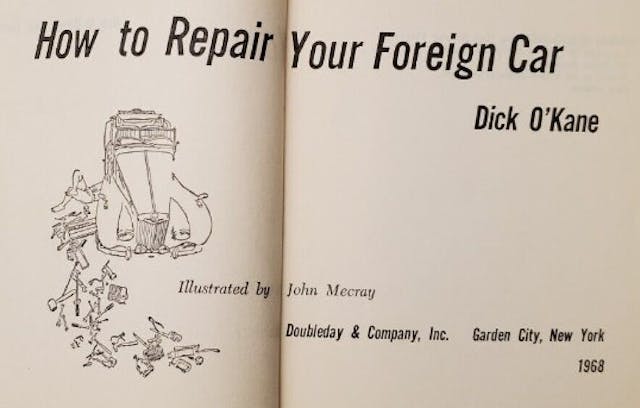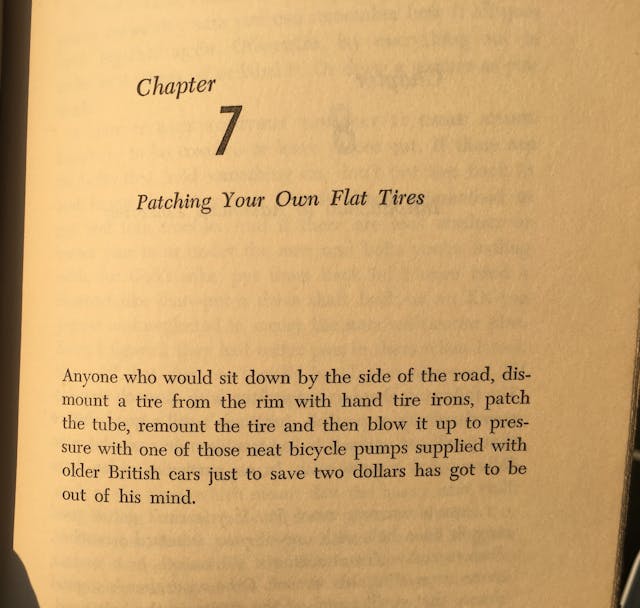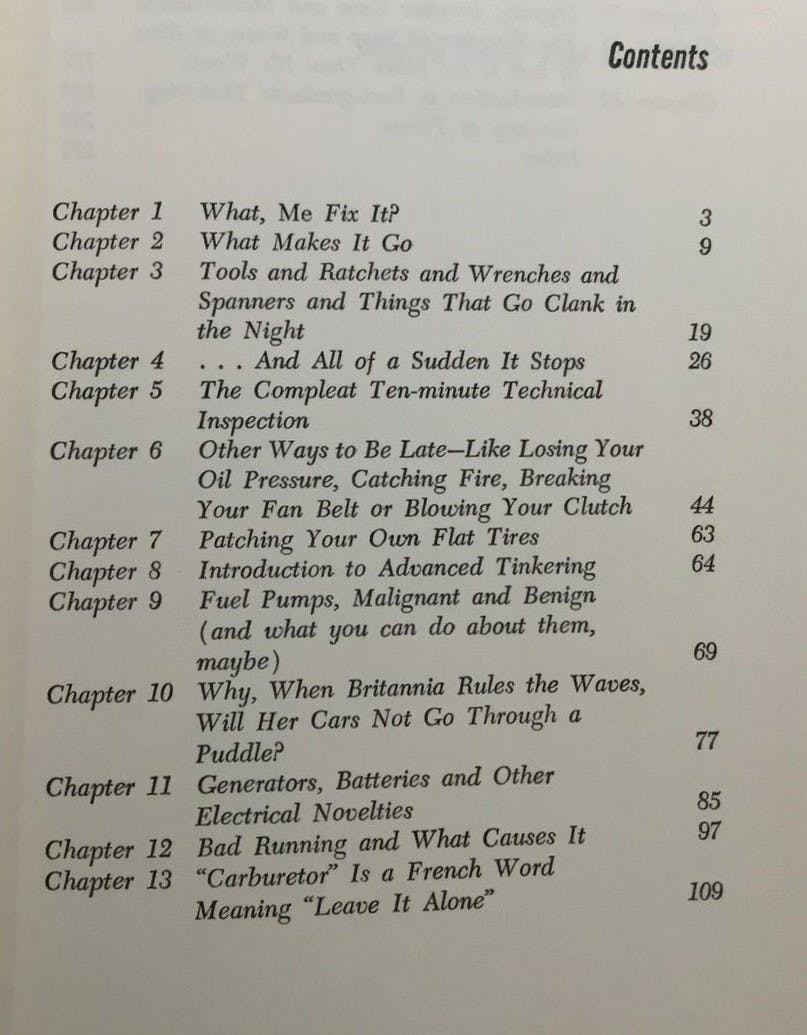A new review of an old book that you may want in your library

I recently had to spend a day in a hospital waiting room while a family member underwent a procedure (they’re fine). I took some unusual reading material with me—How To Repair Your Foreign Car: A guide for the beginner, your wife, and the mechanically inept by Dick O’Kane (Doubleday, 1968). A friend bought it for me five years ago, and I hadn’t gotten around to reading it. I thought something light would be a good counterpoint to the gravitas of the hospital.
Let me back up a bit. The three books that most influenced me as an automotive writer were Zen and the Art of Motorcycle Maintenance by Robert Pirsig, How To Keep Your Volkswagen Alive: A manual of step-by-step procedures for the compleat idiot by John Muir, and Shop Class as Soul Craft by Matthew Crawford. I read Zen when I was in college 45 years ago, and like many young men overly impressed with their own intelligence, loved its odd epistemological ramblings and its tenet that working on a motorcycle is a microcosm of rationality itself. I re-read it when I was writing my first book, Memoirs of a Hack Mechanic, and was surprised by how badly it (or I) had aged. What were mind-blowing Carlos Castaneda-like revelations when I was 18 on the metaphysics of quality now struck me as a self-indulgent series of digressions; the chapter on “stuckness” that I remembered so fondly was a joke; and there was but a single diagnostic example of the kind of Zen-based maintenance that forms the book’s title (the author realized that his bike was running rich at high altitudes and leans it out).
In contrast, the “Idiot Manual,” as John Muir’s Volkswagen book is usually called, really is the “philosophy lesson disguised as a repair manual” that Zen pretends to be. Muir really does dispense hippie-cowboy-Zen wisdom, sort of an automotive version of Sam Elliot’s character in The Big Lebowski. His book was a huge entry point for me into both wrenching and writing. It’s what got me working on my then-girlfriend’s (now wife’s) VW bus in the late ’70s. The idea that a real repair manual can be written in the first person and be entertaining enough to read cover to cover was the inspiration for my book Just Needs a Recharge: The Hack Mechanic Guide to Vintage Air Conditioning.
I thought that Matt Crawford’s Shop Class as Soul Craft bogged down after it came out of the gate, but the third chapter, “To be master of your own stuff,” hit the nail on the head in terms of why it feels so damned good to fix things yourself. I’ll freely admit that I thought, “Well, if he can write about this, so can I” when I was collecting similar themes I’d been writing about for decades for BMW CCA Roundel magazine, and I used them as the basis for Memoirs of a Hack Mechanic.
Then, when I began writing Memoirs, I discovered a fourth book—Old Tractors and the Men Who Love Them: How to keep your tractors happy and your family running, by humorist and CBS Sunday Morning correspondent Roger Welsch. As per the subtitle, this wonderful book delved into the relationship between hobbies/passions and human connection.
To be clear, How To Repair Your Foreign Car hasn’t worked its way in as a fifth face on this automotive literary Mount Rushmore. But it’s a charming little book that’s a decent primer on how to troubleshoot common problems on your vintage car, foreign or otherwise. And, in more than a few places, it’s laugh-out-loud funny.
The author, Dick O’Kane (1936–2019), was a print and television copy writer. How To Repair Your Foreign Car was the first of his eight automotive/mechanical books. Mr. O’Kane had such an endearing gift for flippant names and phrases that you’d assume he was British (he was from Arkansas and Rhode Island). For example, his term for a generic British car is “Trashwell-Snailby,” and when it breaks, you have to take it to “Filth & Greed Motor Imports Ltd.” The sound of a fan belt snapping is “THWOMPETYbangbangbang CLUNK!” Really, the tone of the entire book is contained in the chapter, “Why, When Britania Rules the Waves, Will Her Cars Not Go Through a Puddle?”

Mr. O’Kane’s book is an entertaining readable narrative in which he applies simple common-sense diagnosis and repair to the things that are most likely to be the causes of a car dying or not starting, and offers that if it’s not these things, it’s something more serious and you’ll need to pay for a tow and a repair. There is an appealing economy and clarity in that approach. The neat thing is that his list lays directly on top of the first six of what, for decades, I’ve written about as “The Big Seven” things likely to strand a vintage car (ignition, fuel delivery, charging, cooling, belts, clutch hydraulics, ball joints). The mind-blowing part is that it’s one thing for me to be applying this to the bulk of little “ferrin” cars from the European invasion of the late ’60s and early ’70s that are now 50 years old, and quite another to find the same set of common problems described in a book from 1968 when the cars were nearly new. Although most cars from this era are similar (that is, carbureted and free of emission controls), the “foreign” part of it is there because it was the author’s passion, and it provides a nifty foothold to describe what probably did happen a lot back in the day—if you took a Beetle or a Porsche into a corner service station where the mechanic was used to servicing Chevys and Fords, he’d be flummoxed not only by it not being ’Murican but by the engine being at the wrong end.
The book begins with a “What Makes it Go” chapter, which is quick primer on engines and the suck-squeeze-bang-blow four-stroke cycle, followed by “And All of a Sudden It Stops,” in which car-dies-while-running problems are, as you would imagine, triaged primary as fuel or ignition related (unless they’re accompanied by a large, expensive bang). O’Kane quickly has you examining battery terminals, looking for broken ignition wires, checking for spark, and verifying that the fuel pump is pushing fuel into the carburetor, giving just the right amount of detail for a first troubleshooting encounter if you’re not naturally a grease-under-the-nails person. Subsequent chapters drill down into ignition, fuel delivery, cooling system, charging system, the clutch, and the distinction between car-dies-while-running and car-won’t-start. It’s a good approach. He swims in the old-school waters that rough running is almost always an ignition-related problem, and that “carburetor” is a French word meaning “leave it alone.” Of course, when the book was written, it wasn’t yet old school.
O’Kane seems to get genuine enjoyment out of describing bashing things with a hammer—voltage regulators, SU electric fuel pumps, starter solenoids. This, of course, makes for great writing, and fits with the quintessential experience of driving your, ahem, Trashwell-Snailby in the rain when the car dies. The common thread with these devices is that they contain electromagnets with contact points, and if they’re stuck, a little mechanical persuasion sometimes helps them open or close. I wish that he’d drawn the common thread connecting them, but he is forgiven because his description of the three states of operation of the voltage regulator is perhaps the clearest I’ve seen anywhere.
Given that it’s a 55-year-old book, there are, of course, anachronisms. I laughed every time I read that working on the car yourself would save you from paying the $7-an-hour labor rate at the dealership, or that certain technical questions could be answered by your “dealer shop manager.” More serious is the fact that he says you can check for spark at a plug wire by simply holding it in your hand while someone cranks the engine. This is horrifying. Coil voltages have crept up significantly over the years, and any spark testing should be done by holding the plug connector ¼-inch from ground with insulated pliers.
Furthermore, if the car suddenly dies, O’Kane is correct in telling you to look for broken ignition wires at the ignition coil, but he omits the simple description that the wire to the coil’s “+” terminal should be carrying battery voltage, and the wire on the “-” terminal should connect to the condenser on the distributor. Then again, this is in keeping with the “ferrin car 101” nature of the book; there aren’t scary-looking wiring diagrams anywhere. And the instruction that, if a car is overheating, the stuck-closed thermostat should be removed, is a bit too 1968 to be useful. Yes, thermostats can stick closed, but not all of them can simply be removed. And the stuck-thermostat trope is usually false; hot-running on old cars is almost always due to insufficient heat transfer (clogged radiator) and insufficient air flow (fan and shroud).
But this is just quibbling around the edges. It’s astonishing to me that a concise little book written 55 years ago about troubleshooting and repair of lightly-used foreign cars could still be so close to the mark and be such a joy to read. Not every page contains humor, but when I read the single-sentence chapter on “Patching Your Own Flat Tires,” I laughed so hard that other people in the waiting room began looking at me. And the chapter on “Dignity: Routine Care and Maintenance,” which gives you creative ways to lie about the fact that your precious foreign car is actually dead by the side of the road, is a whole new comic vein that I intend to mine.

I deeply regret that Mr. O’Kane and I never crossed paths, shared libations, and swapped stories before his passing in 2019.
If you have a friend or loved one who is into simple old cars, be they foreign or domestic, and enjoys good writing, hunt down a copy of Dick O’Kane’s How To Repair Your Foreign Car (used copies are available through Amazon vendors). Then wait for the laughter. And for them to bash their voltage regulator with a hammer.
***
Rob’s latest book, The Best of the Hack Mechanic™: 35 years of Hacks, Kluges, and Assorted Automotive Mayhem, is available on Amazon here. His other seven books are available here on Amazon, or you can order personally inscribed copies from Rob’s website, www.robsiegel.com.
Check out the Hagerty Media homepage so you don’t miss a single story, or better yet, bookmark it. To get our best stories delivered right to your inbox, subscribe to our newsletters.




Thanks for the great reminder. I was loaned this book in ’70 or so, right after being dropped into the deep end of the pool – a one-week transition from a labor-trading carpenter into an indebted WV wrenching ‘Apprentice”.
On a side note, any maybe a Hagerty web person will read this, I miss the ability to see the articles I’ve commented on, and the notifications when there are replies or new comments on the same article.
The ability to edit a comment would be nice too, for those times when I get in too much of a hurry to proofread first.
Great books all, but I agree Dick O’Kane’s is in a class by itself. Loaned out my first copy 50 years ago, and now my daughter has my second copy. Taught me the basics back then, and still useful for Morgan repair! Less so for a BMW E46…
O’Kane’s book IS on my Mt. Rushmore of books that made a lifelong positive impression on me. Obviously, it’s less relevant to today’s vehicles, but those of us who started playing with those “furrin” cars back in the day when the local service station mechanic still grumbled about “well, if it were a ‘Murrican” car…” it’s still relevant.
Heck, about 12 years ago, my sister pulled into our driveway with the exhaust of her Daewoo dragging on the ground. I’d long since mastered the art of tin-can exhaust repair, got her fixed up, and all was well. I suggested she check with her regular mechanic when she got back home. She did, and he simply tightened one of the clamps and pronounced it “good to go”!
That book helped a poor 1970s college student to keep his Triumphs on the road, and it still inspires me to this day, especially as “Filth & Greed Imports” now charges about $130/hr for labor!
Nice piece. Hilarious: “Really, the tone of the entire book is contained in the chapter, “Why, When Britania Rules the Waves, Will Her Cars Not Go Through a Puddle?”
I bought a copy of HTRYFC after a new Triumph TR4A and its accursed Lucas electrics entered my life. The copper knock-on hammer wasn’t just intended for the wheels. I still pull that little gem off the shelf when I need a good laugh. Although carburetors have largely disappeared, his French definition still applies.
O’Kane was very entertaining, as were the wonderful Bill Deal cartoons for MG Mitten’s ads in R&T.
If it doesn’t fit, use a bigger hammer.
When I was a callow youth, and my friends introduced me to cars, Minis in particular, this was our Bible. That was when I was going to art school in Philadelphia, circa 1970, and O’Kane was sighted on occasion driving his Jag (see: nigrescent scime), or at Dirty Franks, but I neither smoked (tobacco) nor drank, even if I could’ve afforded it, so I never had the opportunity to screw up the courage to introduce myself and pay homage to he who saved our ass on the road, as it were. I regret not hunting him down in later years.
My wife, who’s been driving since she was 13, and was crewing on F Fords at 16, before I even met her, still quotes from it. She does have a copy of The Idiots’Guide, but the VW disappeared before I met her, so I’ve almost never had to refer to it. As for Zen Etc., it always seemed to be a book for posers, and was ignored. At one point I had two copies, so one for lending, but it got legs at some point and went on vacation. The other is still on the Special Car Books shelf. And I still send people copies of Flight of the Thunder Beetle, and Grendel.
And I believe it was: suck, squeeze, bang, whoosh…
My MG Midget would occasionally refuse to start until I whacked the Lucas starter motor with the lead mallet included in the tool kit (required to service the “UNDO” wheels).
I was heartbroken when my father’s copy of HTRYFC was destroyed in a basement flood before I even had my driver’s license. Now I have two Brits and a German car in my own garage, I am almost willing to shell out $100 for one of the remaining copies at Abe. “Water drips onto your watch, reminding you that you’re already late… ”
So glad you were introduced to that book. It’s like hearing that two dear friends are getting married.
I have to admit I’m surprised you didn’t have this entire book memorized already. I was sure you must have had a copy.
Everything O’Kane wrote was wonderful. I won’t get it right but “Tales of Thunderbeetle and other” (close) was hilarious.
When I was about to embark on grad school over the pond and bought a split window former meat wagon sight unseen, my buddies gave me a copy of “How to Keep Your VW Alive.” Best going-away present ever. That and several years in a 4H Tractor Club.
I think this was the first car book I owned, bought back in college in the late ’60s when I was surrounded by friends with funny little ‘forn’ cars (and owned a 7 year old Dodge). It was hilarious, and quite useful. The admonition about carburetors has stuck with me to this day. My copy of the book is barely 10 feet away still.
Looks like a fun book. Checked online. Holy smokes sellers asking $75 plus
“but he omits the simple description that the wire to the coil’s “+” terminal should be carrying battery voltage, and the wire on the “-” terminal should connect to the condenser on the distributor”
Not all foreign cars are negative grounded.